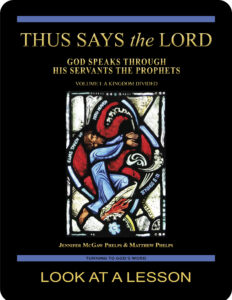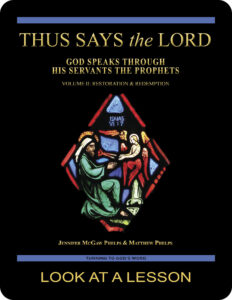Septuagint
 In this column, we occasionally refer to the Septuagint, the commonly accepted translation of the Old Testament into Greek. Its name comes from the Latin word meaning “seventy”; it’s commonly abbreviated LXX, the Roman numeral for 70.
In this column, we occasionally refer to the Septuagint, the commonly accepted translation of the Old Testament into Greek. Its name comes from the Latin word meaning “seventy”; it’s commonly abbreviated LXX, the Roman numeral for 70.
The Septuagint takes its name from the legend surrounding its origin. The legend holds that King Ptolemy II asked 72 Jewish rabbis to translate the Hebrew scriptures into Greek for inclusion in the library of Alexandria. The rabbis worked in isolation in 72 separate rooms, and, according to the legend, they all produced identical manuscripts. Whether or not this legend is accurate, the Septuagint spread throughout the Greek-speaking world. At the time of Jesus, this version of the Old Testament was in much broader use than the Hebrew version because Greek was a much more broadly spoken language. It was considered by Jewish authorities at that time to be a valid translation.
The Septuagint version of the Bible has been incredibly significant prior to discovery of the Dead Sea Scrolls. Before that discovery, the oldest surviving manuscripts of the Old Testament were manuscripts of the Septuagint. All manuscripts written in Hebrew were more recent. Because no two ancient manuscripts are the same, one of the core issues when translating these texts is determining exactly which text to translate. In this process, the oldest available version is of incredible significance.
The Septuagint version of the Old Testament includes a number of texts that originally were authored in Greek rather than in Hebrew. These writings, now often called the apocrypha or the deuterocanonical books, are the six or so books of the Old Testament that are in Catholic Bibles but that many other Christian Bibles omit. (These works that originally were written in Greek are the Books of Tobit, Judith, First Maccabees, Second Maccabees, Sirach, Baruch, and Wisdom, as well as parts of the Books of Esther and Daniel.) They were removed from the Jewish cannon following the destruction of Jerusalem after the death of Jesus Christ in an effort by Jewish rabbis to purge foreign influences from their culture.
you also may like our two-part study of the prophets

 Thus Says the LORD: God Speaks Through His Servants the Prophets—Volume I: A Kingdom Divided examines the prophets in their historical context using the First and Second Books of the Kings and other Old Testament passages written before the Babylonian Exile in 586 B.C. Volume II: Restoration & Redemption looks at the post-exilic prophets. This 51-lesson Catholic Bible study builds on The United Kingdom of Israel: Saul, David & Solomon Foreshadow Christ the King. Click on the books’ covers to view a sample lesson from each volume.
Thus Says the LORD: God Speaks Through His Servants the Prophets—Volume I: A Kingdom Divided examines the prophets in their historical context using the First and Second Books of the Kings and other Old Testament passages written before the Babylonian Exile in 586 B.C. Volume II: Restoration & Redemption looks at the post-exilic prophets. This 51-lesson Catholic Bible study builds on The United Kingdom of Israel: Saul, David & Solomon Foreshadow Christ the King. Click on the books’ covers to view a sample lesson from each volume.
 Click on the picture of the statue of Moses with horns (above) to learn more about Lost in Translation. A new entry is archived each Monday. Contact us to receive Lost in Translation by email every week. You may use any of the contact links on our website to ask Matthew a question.
Click on the picture of the statue of Moses with horns (above) to learn more about Lost in Translation. A new entry is archived each Monday. Contact us to receive Lost in Translation by email every week. You may use any of the contact links on our website to ask Matthew a question.
